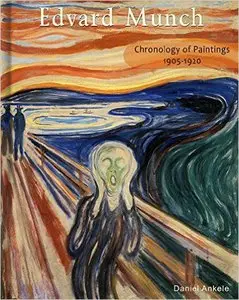Daniel Ankele, "Edvard Munch: Chronology of Paintings 1905-1920"
English | ASIN: B01320DWHC | 2015 | EPUB | 1068 pages | 58,4 MB
English | ASIN: B01320DWHC | 2015 | EPUB | 1068 pages | 58,4 MB
EDVARD MUNCH: CHRONOLOGY OF PAINTINGS 1905-1920 Art Book contains 565+ HD Reproductions of Landscapes and Portraits, Nudes, Still Lifes and Genre Scenes with annotations and biography.
BIOGRAPHY
The sick girl’s fevered head rests benignly on the pillow, while a woman bows low in sorrow by her side. It is a scene of great pathos and strange serenity. The weary resignation in the girl’s eyes as she turns toward her stooped guardian leave us in no doubt that death is the unseen third character of the picture. The young artist knew it too as he painted it in his home, seated upon the wicker chair his sister had died on nine years earlier.
Munch’s mother died of tuberculosis at Christmas when he was just five years old. And even though his aunt moved in to take care of his father and the five children, little Edvard and sister Sophie clung to each other like soul mates. In the following years, cramped within their close quarters in working class Oslo (then Kristiania), frail Edvard was frequently ill himself, often spending half the dark winter confined to bed.
But just as she was approaching womanhood, it was Sophie, not Edvard, who followed her mother, succumbing to the dreaded disease. Once more the family was gathered around a dying loved one, pious father’s hands clenched together in prayer and Edvard silent in his stunned impotence. Sophie begged him to take the ailment from her, as if he was Jesus Christ; he hid behind the curtains to weep. In her final moments Sophie asked to be helped into a chair, where she was propped up like the girl in the painting. That wicker chair was with Edvard until he died six decades later.
“Sophie’s death was a blow from which Edvard never fully recovered,” biographer Sue Prideaux concludes. “A desolate longing for her remained all is life; he had lost his mother all over again.” But that her death found its way into his art time and again, constantly re-experienced, is not only a token of its deep imprint on his psyche. It also is a crucial insight into why Munch was an artist. As Arnold Weinstein puts it, “art kept Munch alive” and “he knew it.” In Munch’s own words, “my sufferings are part of myself and my art. They are indistinguishable from me, and their destruction would destroy my art.” More even than most artists, therefore, Munch’s art, life-motivation, and inner pain were inextricably co-dependent. (cont)



